Overview
The article provides a comprehensive step-by-step guide on how to effectively use inner joins in Power BI, emphasizing their importance for integrating data from multiple tables to generate insightful reports. It explains the process of establishing relationships between tables, the benefits of filtering data for accuracy, and addresses common challenges, all supported by practical examples and case studies that illustrate the efficiency and relevance of inner joins in data analysis.
Introduction
In the realm of data analysis, mastering the art of inner joins in Power BI can significantly elevate the depth and accuracy of insights derived from complex datasets. These powerful tools serve as the backbone of effective data integration, allowing analysts to filter and connect information seamlessly across multiple tables. By focusing solely on matching records, inner joins empower organizations to uncover critical relationships and trends that might otherwise remain hidden.
Whether it’s combining customer data with sales records to analyze purchasing behavior or merging HR metrics with payroll information for comprehensive employee assessments, the applications of inner joins are vast and impactful. However, challenges such as performance issues and data inconsistencies can impede the process.
Fortunately, with the right strategies and tools, including Robotic Process Automation, these obstacles can be overcome, paving the way for more streamlined reporting and informed decision-making. This article delves into the intricacies of inner joins, offering practical guidance and solutions to harness their full potential in Power BI.
Understanding Inner Joins in Power BI
The use of inner join power bi is crucial for integration, as it returns solely those rows where a match is found in both entities being combined. This selective inclusion indicates that when you’re working with two tables, like Table A and Table B, a mutual connection will produce a new table containing only the rows that satisfy the specified connection condition. Mastering this concept is crucial; it empowers users to filter information effectively, enabling a sharper focus on relevant details.
For example, when examining sales data, utilizing a relational merge enables you to effortlessly integrate customer information with sales records, revealing deeper insights into purchasing behaviors. A prominent case study titled ‘Inner Join Power BI Implementation’ illustrates this, showing that a combination results in a table that only includes rows with matching values, effectively filtering out any non-matching rows. Furthermore, Eddie Groves, a specialist in the field, stated, ‘I discovered something intriguing in SQL server while examining if nested connections are quicker than left connections,’ highlighting the performance advantages of nested connections, especially in situations where efficiency is crucial.
However, challenges such as time-consuming report creation and data inconsistencies can hinder the effective use of Power BI dashboards. Overcoming these challenges can be facilitated by RPA tools like EMMA RPA and Power Automate, which streamline processes and enhance operational efficiency. In fact, another user witnessed a significant decrease in query execution time from 5 minutes to only 10 seconds by utilizing OPTION (FORCE ORDER) alongside nested connections.
By understanding and applying inner join power bi effectively, you can support informed decision-making and drive operational efficiency, while also leveraging Business Intelligence to unlock deeper insights for your organization.
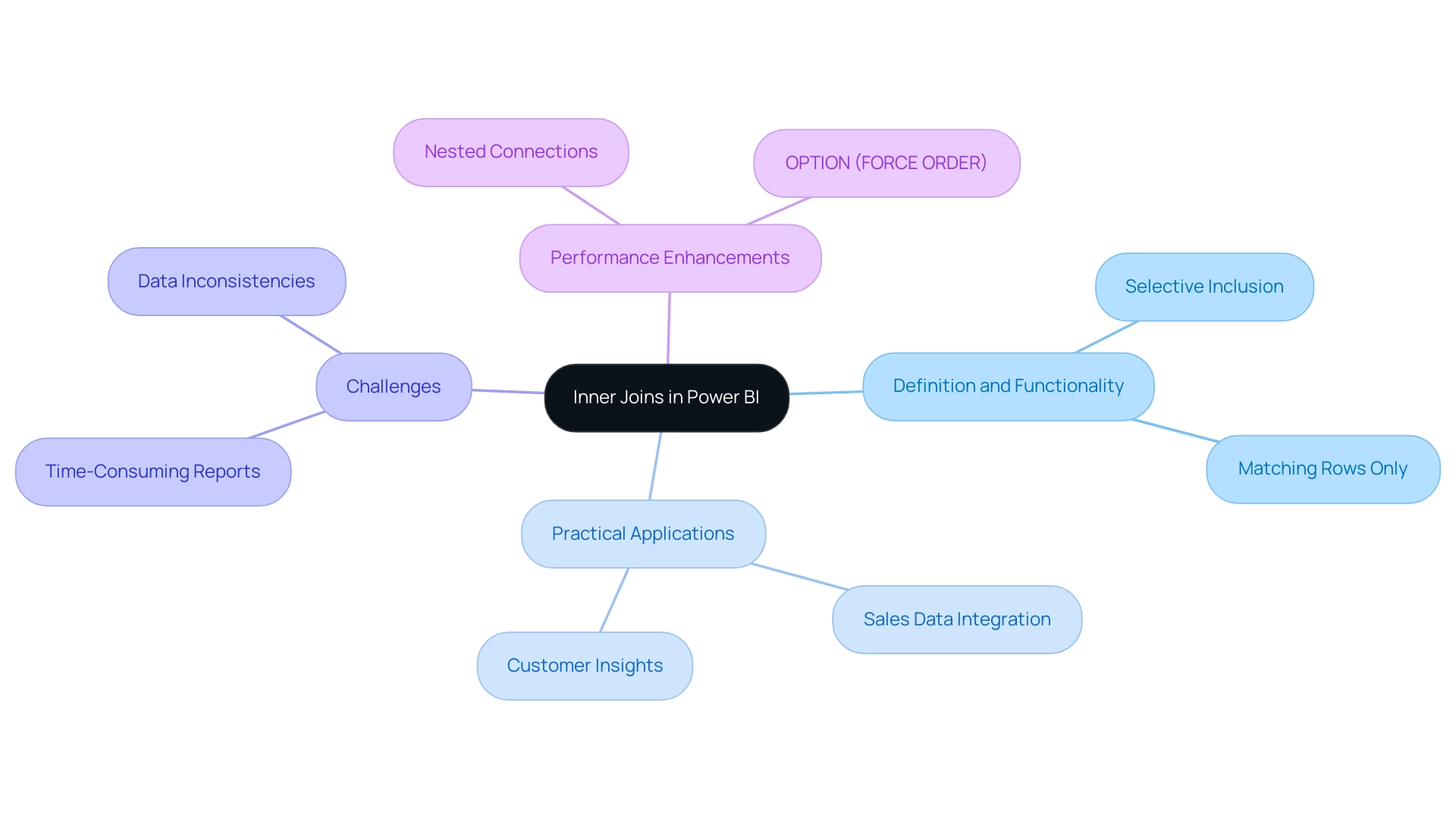
Practical Applications of Inner Joins in Data Analysis
The use of inner join Power BI connections acts as a strong instrument in numerous analysis situations, especially when accuracy is essential. By utilizing SQL connections, you can effectively merge information from various tables according to their relationships, which is crucial for generating insights based on information. For example, when examining a sales database, utilizing a direct connection enables you to concentrate solely on sales records associated with customer information.
This approach ensures your analysis is grounded in transactions involving actual customers, which is vital for generating accurate reports and insightful dashboards that genuinely reflect business performance. Furthermore, internal combinations can integrate product information with sales details, offering a more profound insight into product performance and trends. Merging HR information with payroll records through inner joins also facilitates comprehensive analysis of employee metrics, ensuring that the insights derived are both relevant and actionable.
The importance of proper indexing and understanding relationships between tables cannot be overstated, as these factors significantly enhance performance during integration, addressing common challenges such as inconsistencies and time-consuming report creation. Moreover, integrating RPA solutions such as EMMA RPA and Power Automate can simplify these processes, improving operational efficiency by automating repetitive tasks related to management. A relevant case analysis encompasses the full merging scenario, which emphasizes the usefulness of considering all rows from both datasets, regardless of matches, thereby offering a comprehensive view of the information landscape.
While internal connections enhance reporting in Power BI, understanding their relationship with inner join Power BI further equips decision-makers with insights that promote operational efficiency and strategic initiatives.
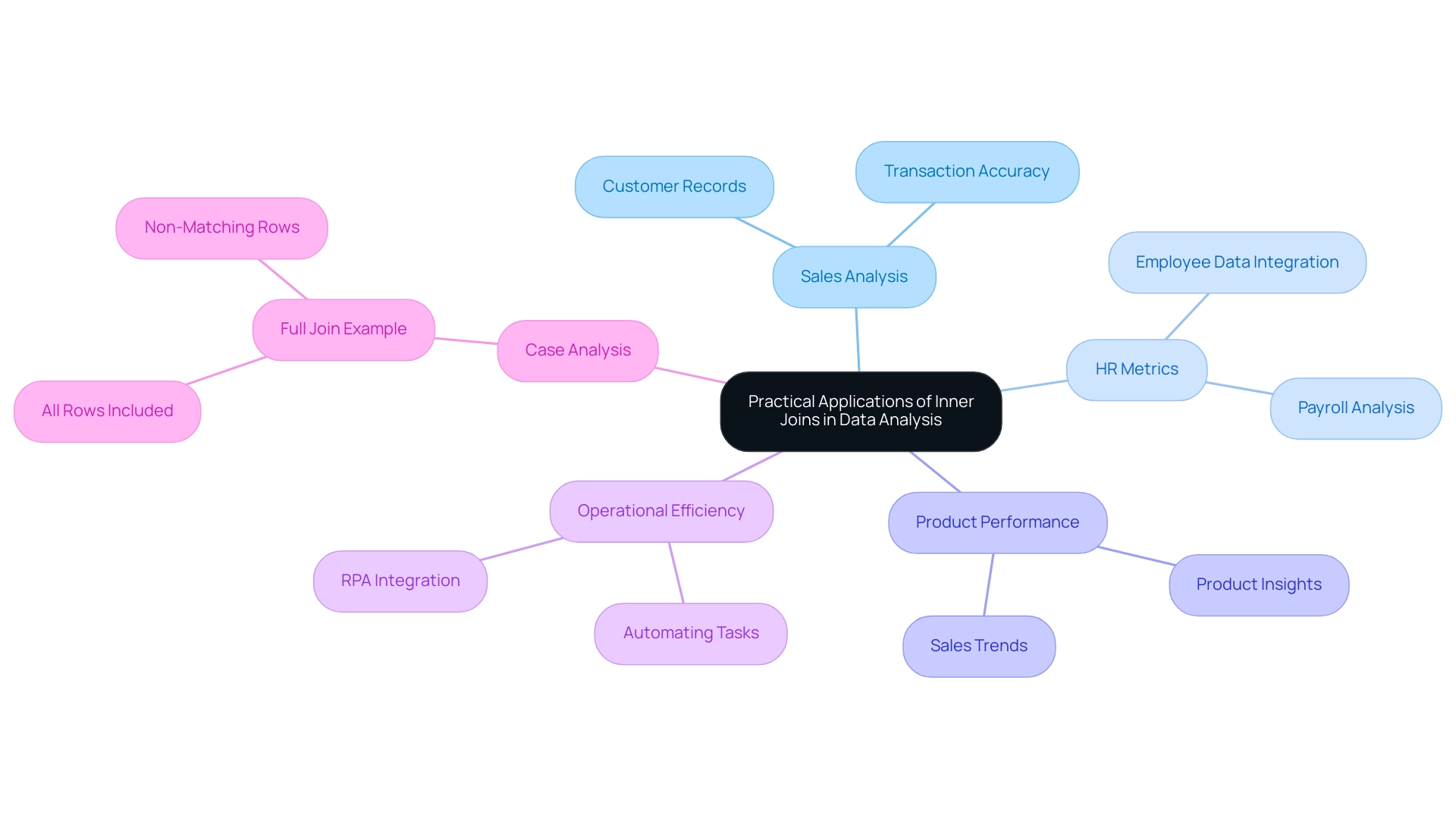
Step-by-Step Guide to Performing Inner Joins
To effectively perform an inner join in Power BI and enhance your data management capabilities, follow these comprehensive steps:
- Open Power BI Desktop: Start by launching the application and accessing your report.
- Load Information: Import the relevant entries into your Power BI model, ensuring that you possess the necessary content for your analysis.
- Navigate to the Model View: Click on the ‘Model’ icon situated on the left side of the screen to access the model.
- Create a Relationship: Drag the field from the first table that you want to join to the corresponding field in the second table. This action establishes a vital connection between the two datasets, which is essential for leveraging insights effectively.
- Set the Relationship Type: Click on the relationship line and verify that the relationship type is correctly set to ‘Many to One’ or ‘One to One’, depending on your specific structure. Accurate relationship settings are critical for optimal data integration and reporting efficiency.
- Utilize the Relationship in Your Report: With the relationship in place, you can seamlessly incorporate fields from both tables in your visualizations. Power BI will automatically execute an inner join based on the established relationship whenever you generate reports, thereby reducing the time-consuming report creation process and enhancing operational efficiency.
By incorporating Robotic Process Automation (RPA) into these steps, you can automate the loading and relationship creation processes, significantly decreasing manual effort and minimizing errors. For instance, RPA can be utilized to automatically import information from various sources, ensuring consistency and accuracy in your datasets. This not only streamlines the inner join process but also frees up your team to focus on more strategic tasks.
Furthermore, examine the case study of Microsoft’s XP&A tool, which highlights the trend of cross-departmental planning and forecasting, demonstrating how effective information management can enhance collaborative efforts across teams. Additionally, be mindful of outliers, such as cars sold for over 180 thousand Reais, which can significantly influence your analysis. By acknowledging these factors, you can ensure a more precise and effective management process while leveraging RPA to automate manual workflows, ultimately driving business growth.
As Mike Sargo, Chief Data Officer and Co-Founder, emphasizes, “A business results-driven development approach needs to underscore all efforts.” This mindset is crucial as you navigate the complexities of information management, much like how a clean windshield is vital for clear visibility on the road.
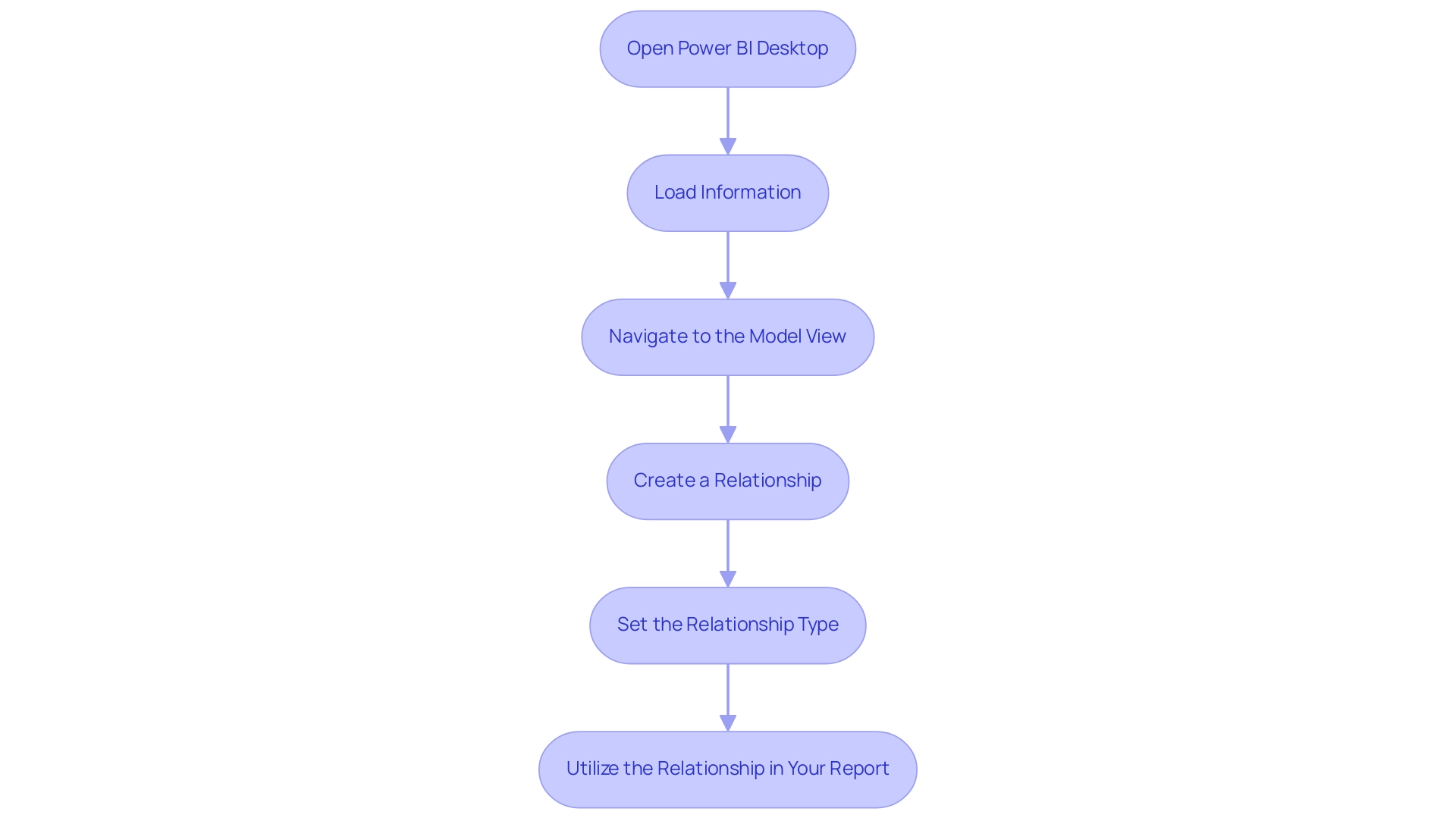
Common Challenges and Solutions When Using Inner Joins
When employing inner connections, several common challenges may occur that can impede information management processes:
- Missing Information: A frequent issue arises when one of the tables lacks corresponding records, leading to gaps in the outcomes. To alleviate this, it’s essential to ensure that your linking keys are precise and that you possess a thorough comprehension of the relationships involved. In the era of overwhelming AI options, having tailored solutions can help clarify these relationships and enhance information integrity.
- Performance Issues: Engaging with large datasets can significantly slow down query performance. It’s important to consider the order of operations in SQL Server, particularly how the inner join power bi and WHERE clauses interact. Applying filters to your information before executing joins can help reduce the volume of information processed and enhance efficiency. Utilizing Business Intelligence tools can also offer insights into performance optimization strategies.
- Complex Relationships: Navigating the intricate connections between datasets can be daunting. Utilize Power Bi’s relationship view to visualize and manage these connections effectively, enabling a clearer understanding of how information interacts across various tables. This capability is essential for driving informed decision-making and operational efficiency, particularly in the context of inner join power bi, as illustrated in the case study titled ‘Inequality Joins,’ which explores the use of inequality operators in INNER JOIN statements. This case study illustrates how a join condition using an inequality can lead to unexpected results, such as a Cartesian product, when not combined with equality comparisons. A more sensible query includes both equality and inequality comparisons, resulting in a meaningful dataset of sales where the price for a given ProductID is less than the ListPrice.
As Amr Saafan, Founder and CEO, notes, ‘Vector Databases are a technology that has emerged as a major game-changer in information management.’ By recognizing these challenges, including the difficulties of technology implementation, and implementing tailored AI solutions alongside RPA to automate manual workflows, you can address potential hurdles in information integration with confidence. This leads to more effective data analysis and decision-making that drives business growth.
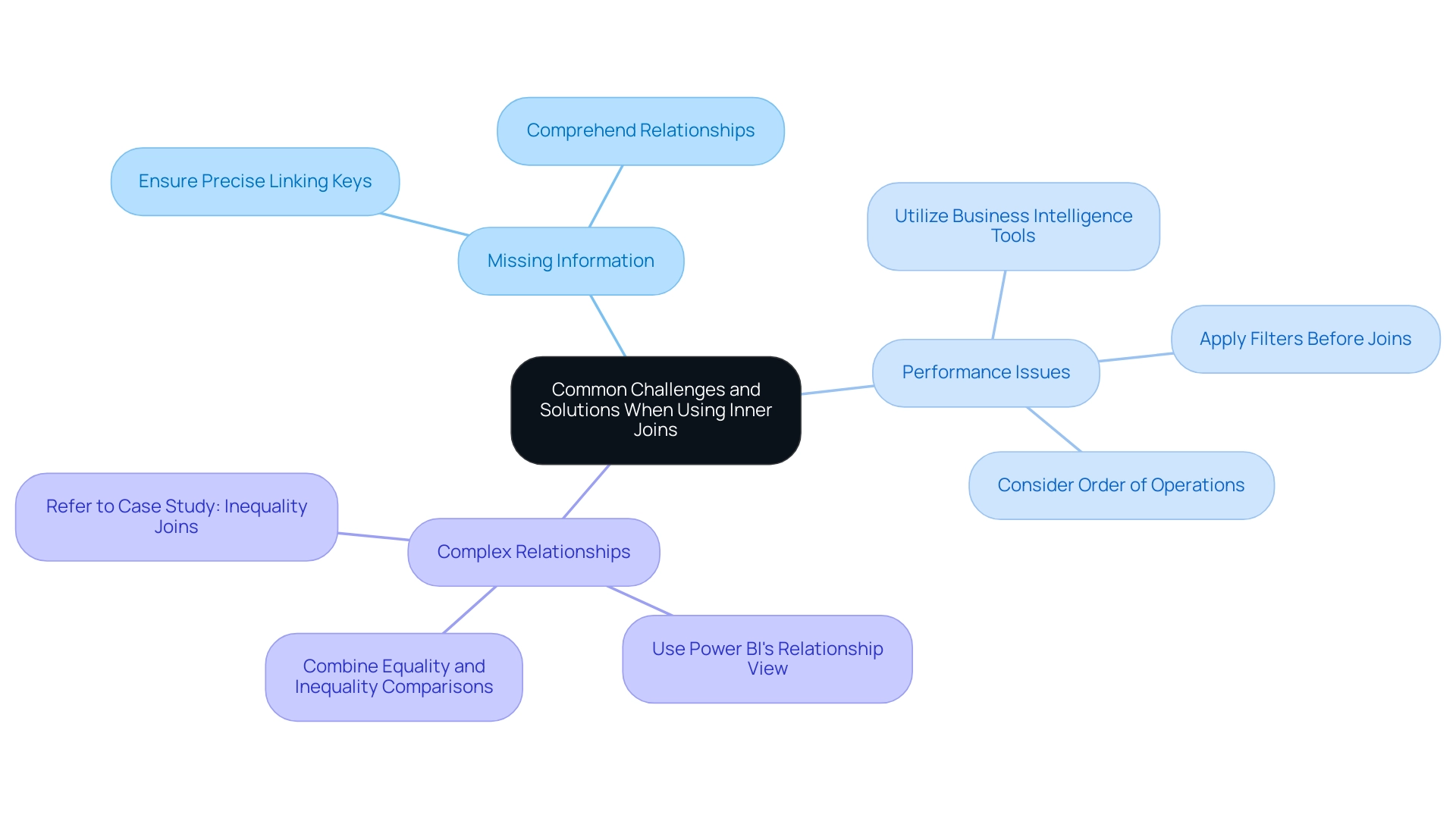
Comparing Inner Joins with Other Join Types in Power BI
Inner combines are different from other connection types in several important ways:
-
Outer Combines: Unlike inner combines, outer combines retrieve all records from one dataset while also returning matched records from the other dataset. This indicates that if a match is not located, the results will still encompass records from the outer dataset. This functionality is crucial for assessments where preserving all information points is significant, such as identifying all clients, regardless of whether they have made a purchase.
-
Cross Connections: Cross connections yield a Cartesian product, producing all possible combinations of records from the two sets involved. This can lead to exceptionally large datasets, making cross merges less practical for most analytical tasks.
-
Right Anti Merge: A right anti merge is particularly useful when the objective is to identify records in the right table that do not have corresponding matches in the left table. This is essential in situations where recognizing gaps in information is necessary, such as pinpointing customers who have not made purchases in a specific timeframe.
Understanding these differences enables users to choose the suitable connection type customized to their analytical goals. For example, if the objective is to examine only transactions with related customer information, using an inner join power bi is the optimal option. In contrast, when the analysis requires visibility into all customers—including those who have not made any purchases—an outer connection would be more suitable.
By integrating Robotic Process Automation (RPA) into these workflows, businesses can automate the tedious processes associated with report creation, significantly reducing the time spent on manual tasks. For instance, RPA can optimize the execution of merging operations by automatically creating queries based on established criteria, thereby reducing human error and accelerating information retrieval. This enables teams to concentrate on utilizing insights from Power BI dashboards, improving operational efficiency.
A case study demonstrating this in practice is the Sales Analysis project, where the inner join power bi was utilized to filter out sales not found in the Country table, leading to a refined dataset (Sales2) that only included valid sales information. Following this, a left combination was applied to include salesperson names, ensuring comprehensive representation of all sales, even those without corresponding names in the database. This method emphasizes the practical use of combination types in achieving effective information integration and analysis within Power BI.
Moreover, comprehending the technology used to access reports—whether through PowerBI.com, Mobile, or Embedded—can affect how combination types are employed across various platforms, highlighting the significance of context in information analysis. Statistics suggest that using inner join power bi usually produces more efficient query performance than outer joins, making them preferable in scenarios where completeness is not as critical. Addressing the challenges of time-consuming report creation and ensuring actionable guidance from data insights is essential for maximizing the value derived from Power BI reporting.
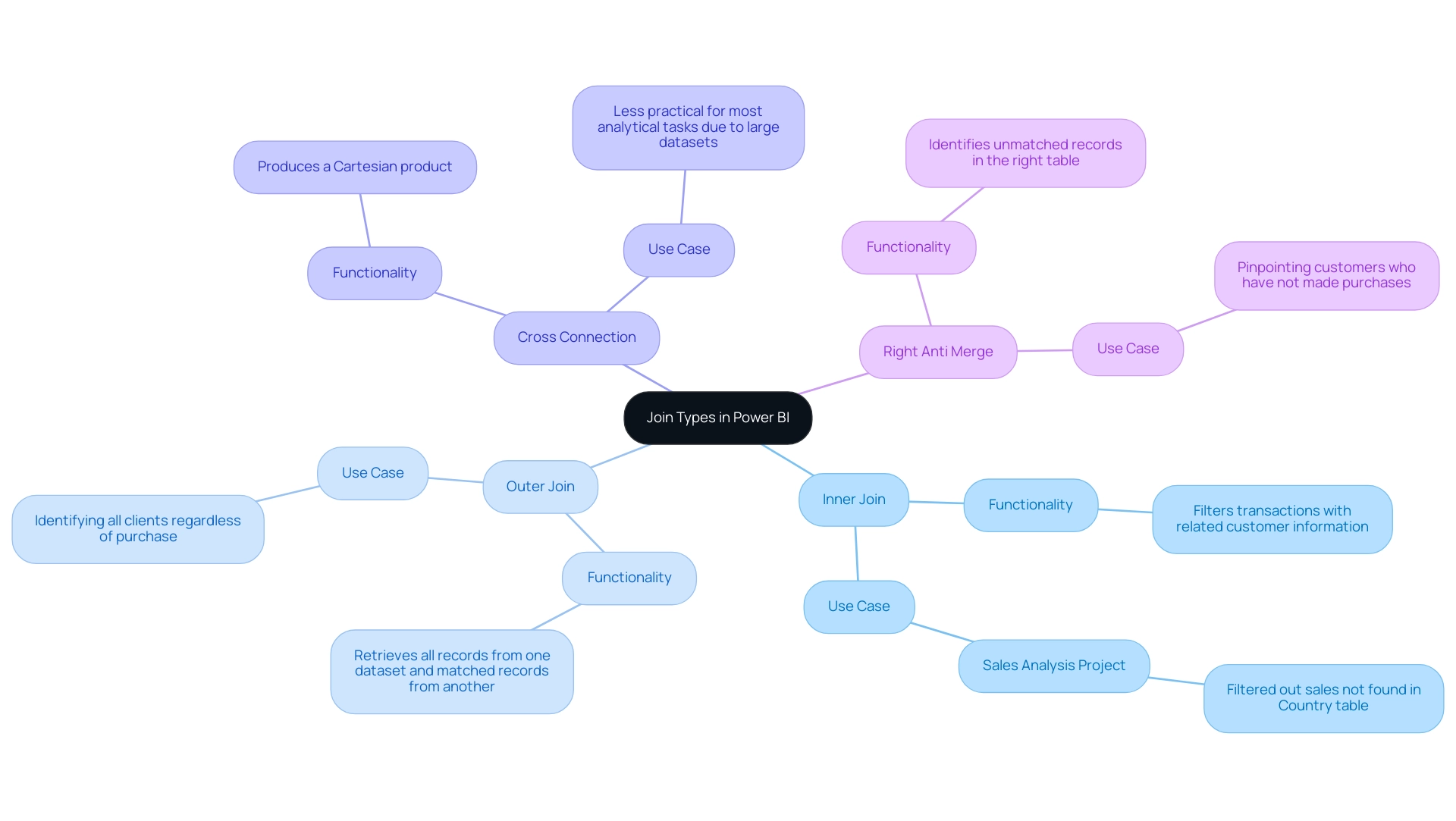
Conclusion
Mastering inner joins in Power BI is a vital skill for data analysts aiming to enhance the quality and relevance of their insights. By focusing solely on matching records, inner joins streamline data integration, allowing organizations to derive meaningful conclusions from their datasets. The ability to combine customer and sales data, or HR metrics with payroll information, exemplifies how inner joins can reveal critical trends and relationships that drive informed decision-making.
Despite the benefits, challenges such as missing data and performance issues can arise, potentially hindering effective analysis. However, implementing robust strategies, such as leveraging RPA tools like EMMA RPA and Power Automate, can alleviate these obstacles, enabling smoother processes and improved efficiency. By automating data management tasks, organizations can focus their efforts on strategic initiatives rather than getting bogged down in manual workflows.
In comparison to other join types, inner joins stand out for their precision and efficiency, making them the preferred choice when the goal is to analyze specific transactions linked to relevant data. Understanding when to utilize different join types further empowers analysts to tailor their approaches based on the analytical objectives at hand.
Ultimately, the effective use of inner joins in Power BI not only enhances operational efficiency but also unlocks deeper insights that can propel business growth. By overcoming challenges and embracing innovative tools, organizations can fully harness the power of their data, transforming it into actionable intelligence that drives success.

